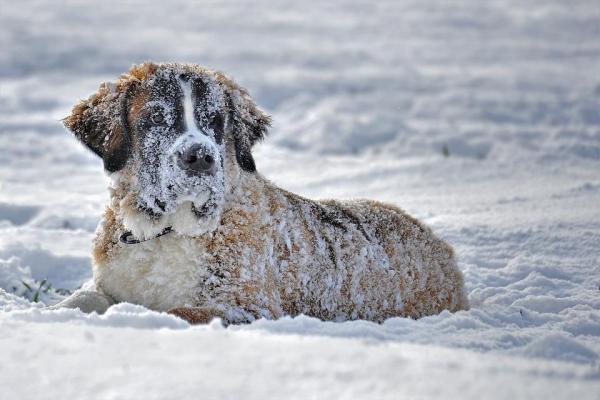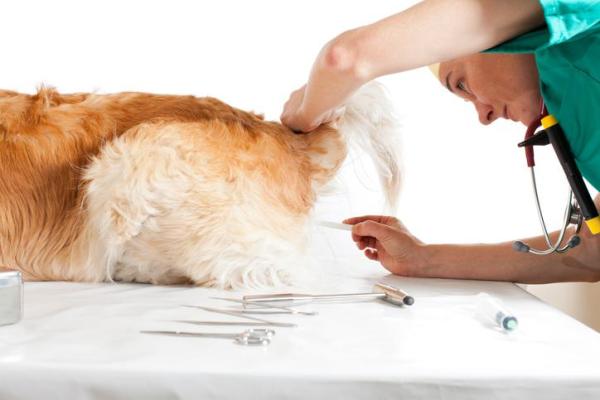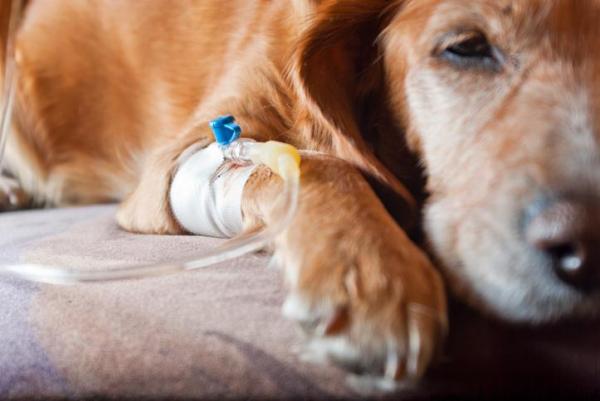Hypothermia in Dogs - Symptoms and Treatment



See files for Dogs
As winter approaches, many dog guardians can wonder how the cold will affect their dog. They will want to protect their canine pals from a very low body temperature and the related concerns brought about by wold weather. Although some dogs are better protected from the cold than others, such as the Siberian Husky or Saint Bernard, the cold affect any breed. We do need to be extra careful with some breeds, dogs with short coats and otherwise vulnerable animals.
Exposure to the cold, snow, wind or heavy rain can increase the chances of the common cold. However, when the exposure is long enough and the temperature low enough, hypothermia can set in. This presents a potentially lethal situation for your dog, so keep reading AnimalWised as we explore hypothermia in dogs along with its symptoms and treatment.
What is hypothermia in dogs?
Hypothermia is a complex clinical picture, but it can be characterized as a significant decrease in body temperature. It can happen to many different animals, not just mammals. Each animal will have a different core body temperature, but once this drops below a certain point, the dog will become hypothermic. Essentially, more heat leaves the body than can be absorbed, something which happens in very low temperatures.
A dog's core body temperature is between 100ºF and 102.5ºF (38ºC to 39.2ºC). When it drops below this temperature, hypothermia is setting in. It is possible to have a small margin of error, especially depending on the method of taking the dog's temperature. However, when a dog's body temperature drops below 36ºC, we need to be alert to the appearance of any other symptoms as this would mean we need to take the dog to the vet immediately.

Symptoms of hypothermia in dogs
In general, the first symptoms of hypothermia in dogs start of similar to a dog experiencing cold temperatures. In Mild to moderate cases of hypothermia in dogs, symptoms may include:
- Tremors
- Muscular stiffness
- Cramps
- Slow breathing
- Difficulty breathing
- Dry skin
- Slow movement
- Clumsiness
- Lethargy
- Drowsiness
In the event that hypothermia is not treated quickly and adequately, the dog's clinical picture can deteriorate rapidly. This will likely lead to the following symptoms:
- Low blood pressure
- Slowing of heart rate
- Depression
- Dilated pupils
- Satring
- Disorientation
- Loss of appetite
- Collapse
- Faiting
- Sudden death
Causes of hypothermia in dogs
In the vast majority of cases, the cause of hypothermia in dogs will be due to exposure to the cold or cold exacerbated by other severe weather conditions. For this reason, dogs which live outside the home or in regions with inclement climates are at greater risk of developing hypothermia. They may also be predisposed to developing other medical problems related to cold weather such as kennel cough or developing joint problems such as osteoarthritis.
However, dog owners who live in colder climates may be well-versed in protection from the cold in general. It is also possible that a freak cold spell or unforeseen exposure to cold temperatures are the cause. Healthy dogs with a very low body temperature are still vulnerable to hypothermia.
There are some conditions which can make regulating body temperature more difficult. Such diseases and metabolic disorders include hyperthyroidism. Dogs which have these conditions will need extra care when being exposed to the cold. Smaller dogs and hairless dogs are also vulnerable to the cold, as are dogs which have been used to warmer climates.
Puppies are particularly vulnerable to cold weather and adverse climates. Their immune system is in its early stages of development and their body is not yet ready to fend off the effects of the cold. Neither are puppies able to regulate their body temperature as effectively. Senior dogs are also more vulnerable. Their immune system becomes weakened by age and are more susceptible to contracting related diseases. Although they won't always lead to hypothermia, they might be weakened by the cold.
Even when the environment seems relatively mild, your dog may be near a water source which is very cold or icy. Many dogs can withstand even very cold water temperatures, but not always. If a dog falls into very cold water, be careful about endangering yourself if you consider going in after them.
Treatment for hypothermia in dogs
If you suspect your dog has been exposed to the cold and you observe some of the symptoms mentioned above, it is essential you go to the vet urgently. Severe hypothermia can cause irreversible damage to the body, leading to death in acute cases.
As the dog's body temperature decreases, a fall in both blood pressure and heart rate occurs. This can lead to the appearance of arrhythmia. In humans, “ventricular arrhythmias are recognized as a principal cause for a high mortality rate in [patients with accidental hypothermia]”[1]. Similarly, the cold exposure can cause the heart to stop beating in dogs. The individual dog may also experience a decrease of oxygen in the blood, a halting of their metabolism and, eventually, hypothermia can lead to complete multiple organ failure.
To treat hypothermia, a specialist will need to offer a suitable environment to bring the dog back to a stable temperature. However, this will need to be done gradually as putting too much temperature on the dog may cause their body to go into shock. The dog should not move around too much to both prevent further heat loss and to prevent them from weakening. Heating the dog may be done with hot air, warming pads, infrared lamps or simply some blankets.
If the case is of acute hypothermia, the dog may need extra treatment. This might include IV fluid therapy to help their blood volume as well as to be used as means to bring up their core temperature. For this later purpose, enemas may also be administered. The dog may also be given oxygen to help assist with their breathing and ensure enough oxygen is getting to their blood.

First aid for hypothermia in dogs
If you observe several of the symptoms of hypothermia in a particular dog, you should go immediately to the veterinary clinic or hospital. However, the action you take en route might help give them the advantage needed to prolong their life. This is why you should know some first aid for dogs with hypothermia:
- Dry the dog immediately: in case the dog has fallen into very cold water or is wet by the elements (rain, snow, etc.), we should immediately try to clean them with a dry towel. Humidity favors the development of hypothermia in dogs when combined with very low temperatures.
- Shelter and warmth provision: when the dog has been dried properly, we should provide heat to try to redress the balance of their temperature loss. This can be done by wrapping them in another dry towel, a blanket, a coat or some special dog clothing. We can also hold the dog in our arms or hug them close to transfer some of our body temperature. This provides a consistent, but not to rapid heat transfer.
- Balance blood glucose levels: to prevent a decrease in body temperature and vital bodily function, the body needs to burn its energy reserves. This is to say, it accelerates the metabolism of glucose in the bloodstream to try to remain in a stable condition. As a result, the dog may suffer from a sudden case of hypoglycemia, i.e. a drastic reduction in the levels of glucose sugars in the blood. This can lead to fainting, lethargy and even result in a comatose state. If we identify the symptoms of hypoglycemic shock, we can offer them a teaspoon of honey to quickly replenish their blood sugar levels. However, honey should be avoided in puppies.
- Check their body: exposure to extreme cold and hypothermia can cause injuries or burns associated with freezing temperatures. It is recommended to delicately check the body of the dog for signs of injury. In particular, attention should be paid to areas with a low concentration of hair such as the paws, ears, legs, snout, anus, tail and genitals. If you identify any injury, it is essential to go to the veterinarian quickly.
We must emphasize the importance of recognizing that these measures are first aid to help give the dog the best chance of recovery. They will help to bring the dog into safety and fight the onset of any associated health problems. However, we still need to take them to the vert for a proper examination. There may be damage which the dog has suffered after exposure to the cold. The vet can establish an adequate treatment program and be better able to maintain a stable body temperature.

How to prevent hypothermia in dogs
To prevent hypothermia in dogs, it is essential we provide adequate care during winter. We need to ensure they are not left outside when temperatures are too low, we offer them shelter from wet conditions, they are given extra protection if they need it (in the form of dog clothing) and we take extra care when out walking in cold weather conditions. We also need to be vigilant for signs of exposure or hypothermia. Providing an adequate diet, preventive medicine and maintaining exercise all will help to give them a fighting chance if they do develop hypothermia.
This article is purely informative. AnimalWised does not have the authority to prescribe any veterinary treatment or create a diagnosis. We invite you to take your pet to the veterinarian if they are suffering from any condition or pain.
If you want to read similar articles to Hypothermia in Dogs - Symptoms and Treatment, we recommend you visit our Other health problems category.








